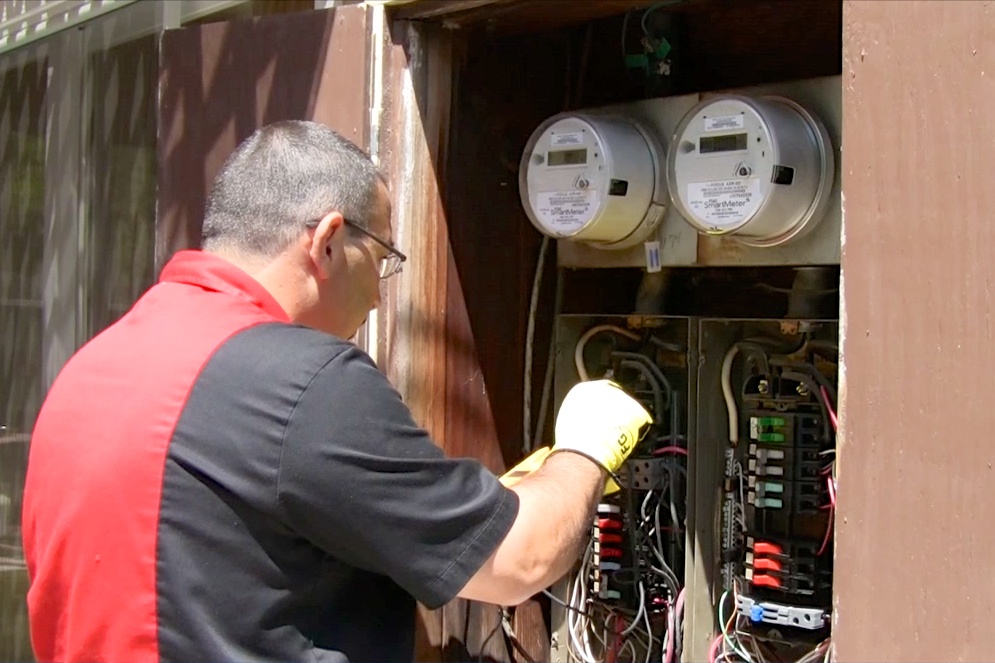Is it Time to Update Your Electrical Panel?

A qualified electrician can determine if you need to replace your home’s electrical panel. Photo: E.G. Electrical Services ©2019
Even though Bay Area residents are known for embracing the newest gadgets and technology, homes in the region tend to be on the older side—in fact, nearly half of all units in San Francisco were built before 1940. Some of these older homes still have their original wiring and electrical panels, which can be problematic or even dangerous as the electrical requirements of a household grow.
Electricity and Older Homes
If you’re planning to renovate your home or upgrade your appliances, it’s important to consider how it may affect your household energy usage. An electrical panel that hasn’t been updated in decades may not be able to handle modern energy requirements.
Fuse boxes: Older homes may still have fuse boxes rather than circuit breaker panels. Fuses are more sensitive to increases in electrical usage than modern breakers. If you’re frequently replacing blown fuses, that means your home is running at the higher end of its electrical capacity and it’s time to upgrade. Also, fuse boxes don’t support GFI circuits, which protect against shock and are generally installed in places where outlets may be exposed to moisture. If you plan to redo a kitchen or bathroom, GFI outlets will be part of the plan, and if you still have a fuse box, it’ll need to be replaced.
Amperage: To handle all the appliances and electronic goods of today’s households, new homes are usually built with 200 Amp service or higher, which has been the standard for more than two decades. Older homes may have been built with 100 Amp service, and those built before World War II may still have 60 Amp service. If you have an older home and are planning on installing a new HVAC unit, washer-dryer or electric stove, you’ll need to confirm that your home has the capacity to handle the appliance’s electrical needs.
Safety Issues With Older Electrical Panels
Some older models of electrical panels have been shown to be unsafe for residential use. Whether or not you plan on remodeling your home or upgrading appliances, if your home has an unsafe electrical panel, it should be replaced. Two common examples are Federal Pacific panels and Zinsco panels, neither of which meet today’s safety standards.
Federal Pacific panels were installed in homes from the 1950s to the 1980s. These panels can work without problems for decades, but they’ve been found to have several serious design flaws. By today’s safety standards, the wiring and breakers are overcrowded. Additionally, some panels have manufacturing defects that prevent the breakers from tripping when overburdened. The result is that components of Federal Pacific panels can melt and even catch fire.
Zinsco panels were installed in new homes during the 1970s. As with Federal Pacific panels, they can operate perfectly for years, but they still pose a serious safety hazard. As a household’s energy demands increase, the components of the Zinsco panel can overheat and melt; the breakers will no longer trip in the event of a power surge, putting those in the home at risk of electrical shock or fire.
If you have an older home, check the electrical panel to determine if it was made by one of the above manufacturers. Today’s panels have black breaker handles, whereas Federal Pacific and Zinsco breakers have color-coded handles.
Power Surges and Rolling Blackouts
Power surges occur when there’s a sudden increase in the amount of electrical current coming into a home. This surge of electricity can cause damage to appliances and electrical systems. We often think about power surges resulting from lightning strikes, but they occur far more commonly when there’s a sudden increase in electrical demand from household appliances. Older electrical panels are at greater risk of being affected by power surges.
Bay Area residents should give more consideration to the possibility of power surges in light of PG&E’s rolling blackouts, in particular those with older electrical panels. The utility company has scheduled times when it will cut service to customers in order to perform power line maintenance around the Bay Area. When power is restored to a home after an outage, there’s a spike in electrical demand from the home’s HVAC unit, refrigerator and other electronics. If many appliances were left running before the scheduled outage, it could result in a power surge when electricity is restored. PG&E provides information online on how to prepare for a scheduled power outage.
Use Diamond Certified Resource to find top rated companies.
Local, Top Rated Diamond Certified Companies Related to Your Topic
San Francisco Electrical Contractors
Contra Costa County Electrical Contractors
Marin County Electrical Contractors
San Mateo County Electrical Contractors
Santa Clara County Electrical Contractors
Related Articles
The Homeowner's Guide to Electrical Services
Get Expert Advice From Owners of Top Rated Local Companies
Become a Diamond Certified Preferred Member (Always Free)